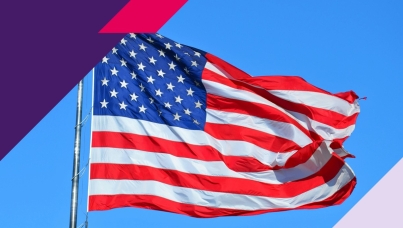

The Ipsos Vibe Check: Here's how Americans feel about the government this week
Updated Dec. 17, 2025, 2:29 p.m.
With everything going on in the U.S. these days, and COVID-early-days levels of uncertainty, we started a module in the Ipsos Consumer Tracker called the Ipsos Vibe Check. It asks a two-part question: How uncertain are you feeling about the impacts of the actions of the government and how satisfied do you feel?
Explore our interactive chart to see how it's changed from week to week, and scroll further to read an in-depth analysis of each wave.
Week of Dec. 8, 2025: We finish the year uncertain. Almost every group has drifted back across the border into More Uncertain, and are hovering on the border between More or Less Satisfied. Republicans have course-corrected a bit. After a wave that found even the base shifting to the left side of the chart, Republicans are back alone in the positive quadrant of Less Uncertain, More Satisfied. After almost a year of tracking the Vibe, every group has shifted toward More Uncertain except Democrats, who frankly didn’t have a lot of room over there to start with, so they have slid slightly back. We’ll be back with the Vibe Check next year and will make a useful change to the chart itself. Stay tuned, and we’ll see you in 2026!
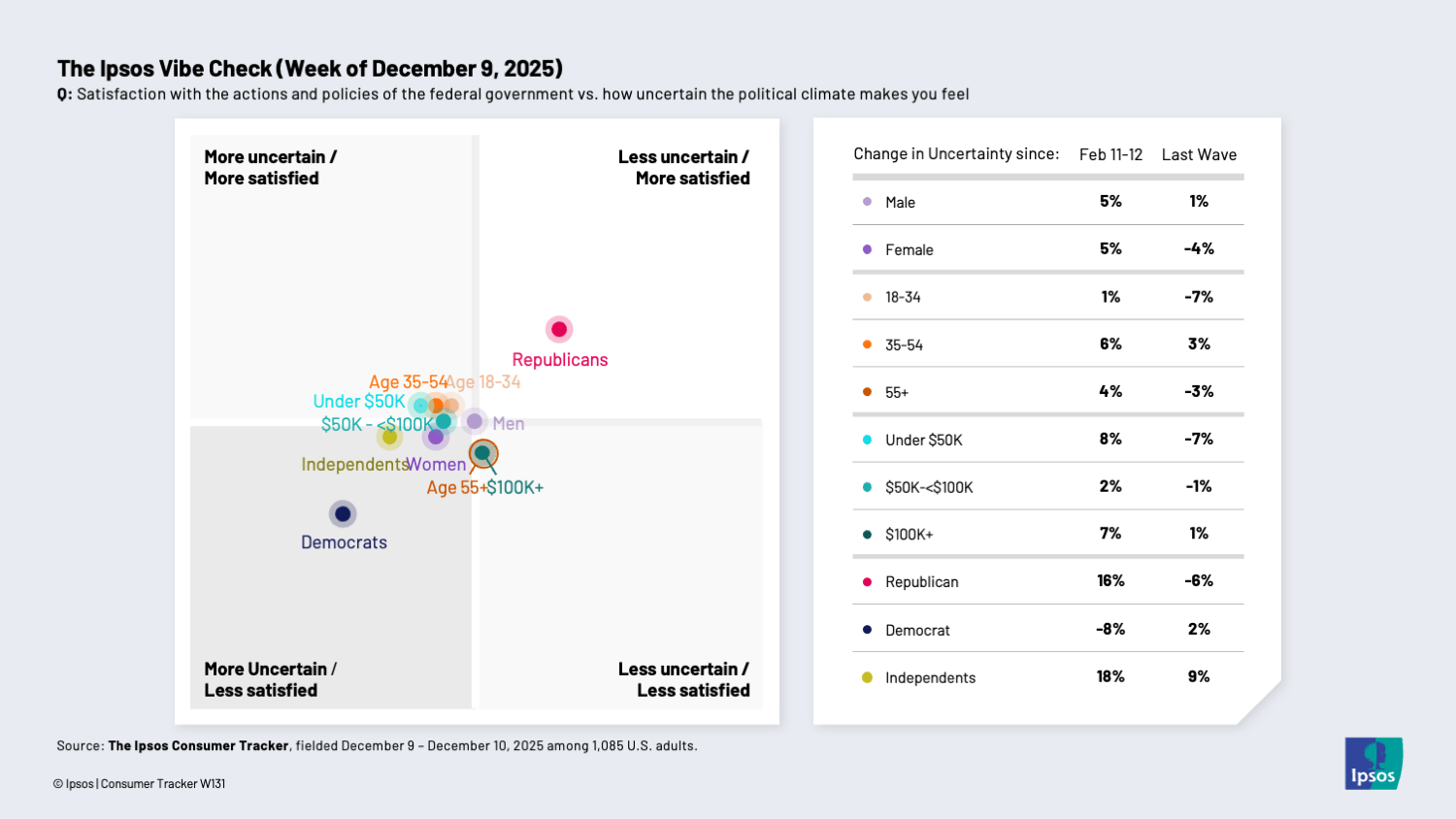
Previously on the Ipsos Vibe Check:
Week of November 4, 2025: In our last wave, we saw everyone slide toward less uncertain and less satisfied. All kinds of stuff is going on in the news (and a very Know/Care wave this week in the Care-o-Meter). There was plenty of uncertainty for the tens of millions who (maybe) receive SNAP benefits as the shutdown was still looking gridlocked at fielding. The Federal Reserve did drop interest rates. While inflation is driving costs of goods, we haven’t seen massive impacts of tariffs (yet?).
So this wave mostly continues that movement toward less uncertain, but less satisfied, with the notable exceptions of our political identities. Democrats didn’t budge this wave. And Republicans are moving counter to most other groups, sliding to the left and more uncertain. We’ll take one more look at this in 2025.
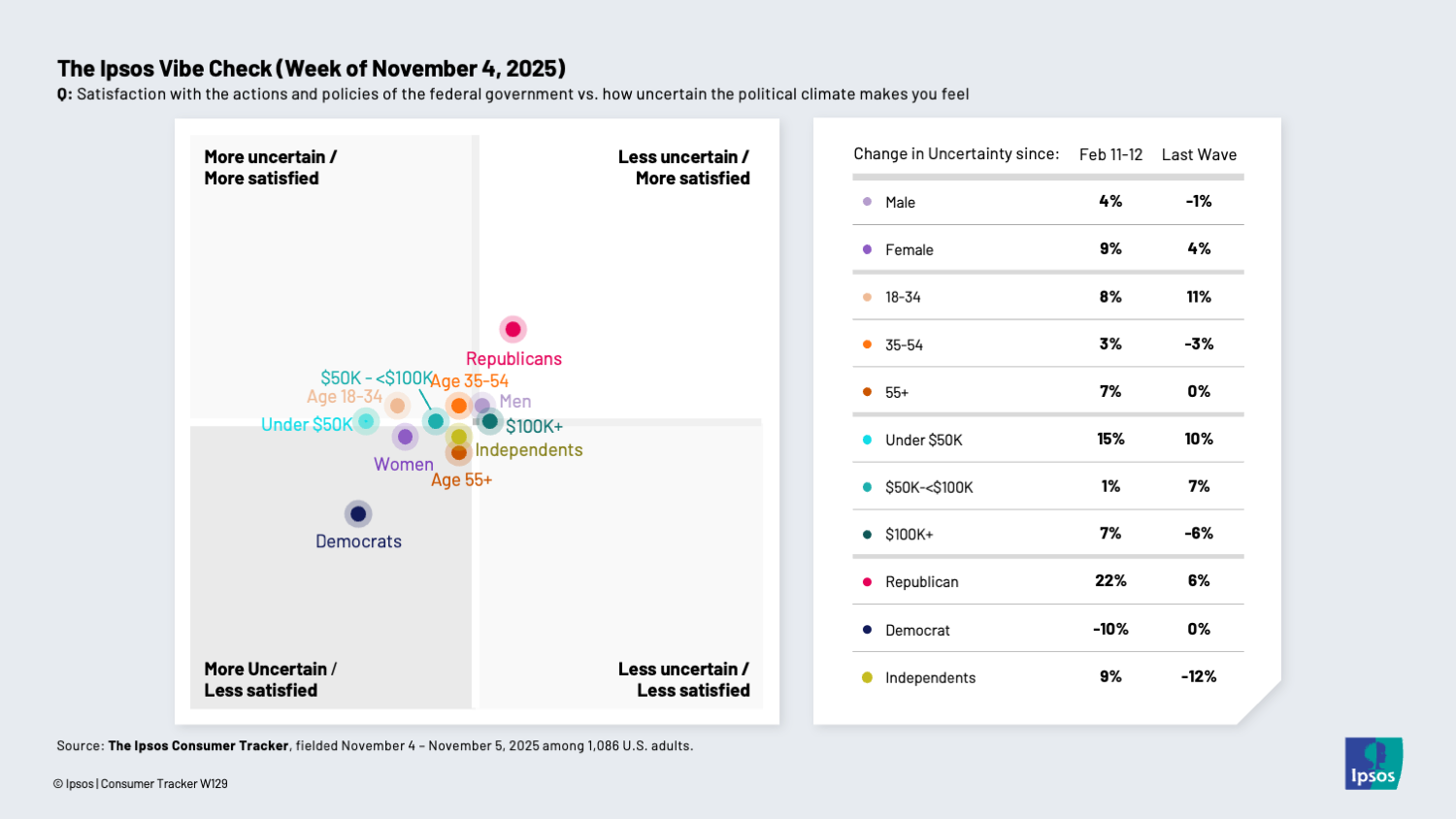
Week of October 22, 2025: Reversing several waves that saw all groups drifting more uncertain and starting to spread apart a bit, this wave sees a bounce back toward more certain and even a drift toward more satisfied. We’ll keep an eye on it, of course. It could be a blip that could shift back next wave. But after an eventful couple of weeks, the next wave could certainly move of its own accord.
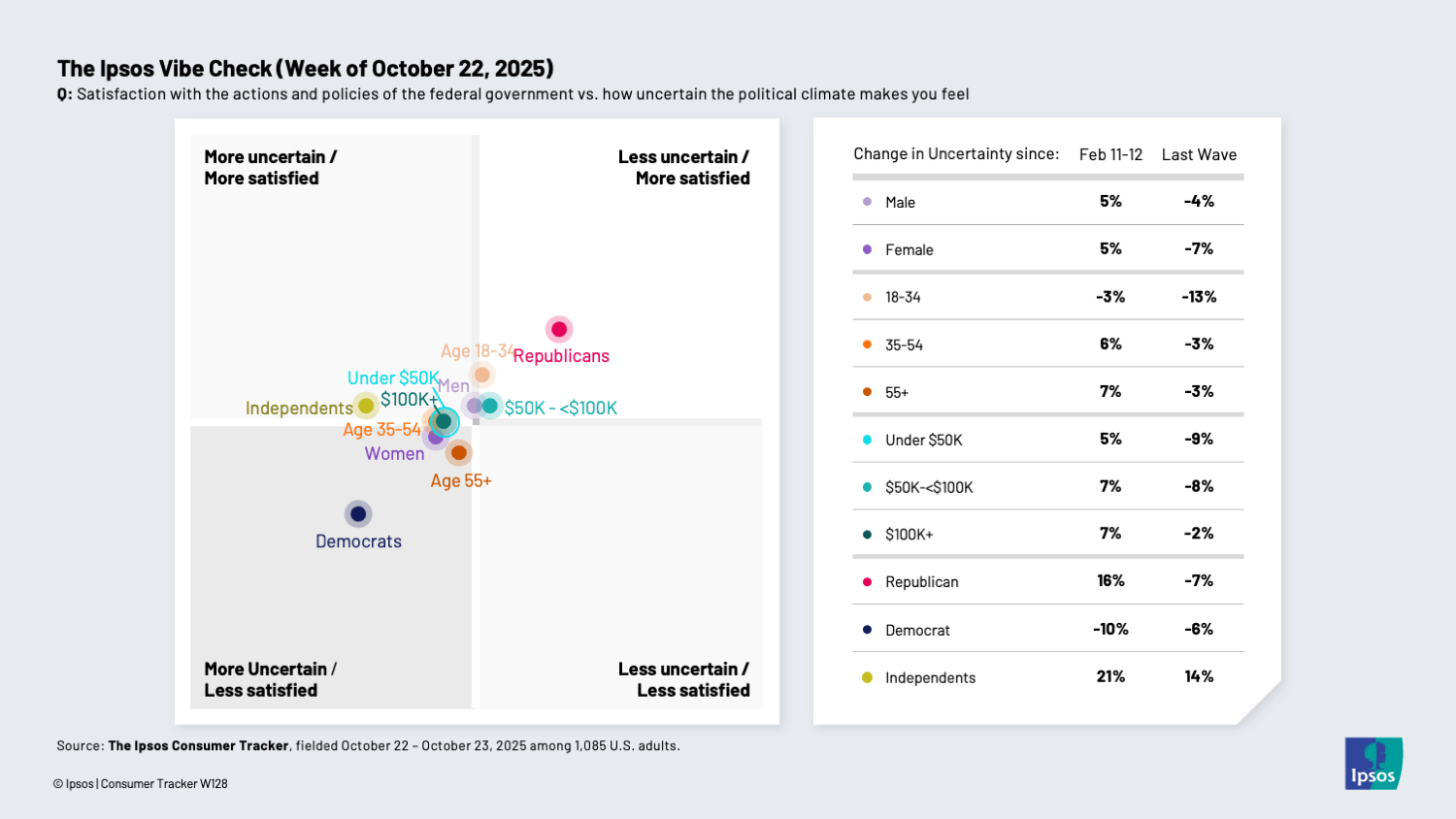
Week of October 6, 2025: This wave continues the striation we noted in the previous wave. Since we started the Vibe Check in February, the various demographics had moved around largely as one big floating blob with the political ID labels as complete outliers. Two weeks ago, the more Republican-leaning demos (older, male, higher income) had started to pull away from the others. Now, as the federal government shuts down and everyone blames each other but also some factions of the GOP like Rep. Marjorie Taylor Greene (R-Ga.) are also blaming the Republicans, we see some new wrinkles. The Republican dot has moved much closer to “more uncertain,” and the Democrats’ dot has moved closer to the rest.
Meanwhile, just a month ago, every dot was on the “more satisfied” side and some had even joined the Republican dot in more satisfied/less uncertain. Now, none of the dots are on the “less uncertain” side, except the Republicans, and many demos, including women, 55+ and everyone making less than $100k, are in more uncertain/Less satisfied.
Now, granted, through all of this movement, most dots are still mostly clinging to both axes. Few demos have strayed too deeply into any quadrant. But once again, the Vibe Check is showing an ever-shifting, never confident sociopolitical situation, where other than our Party ID tribes, it’s hard to gauge where people’s minds are at and how long they’ll stay there.
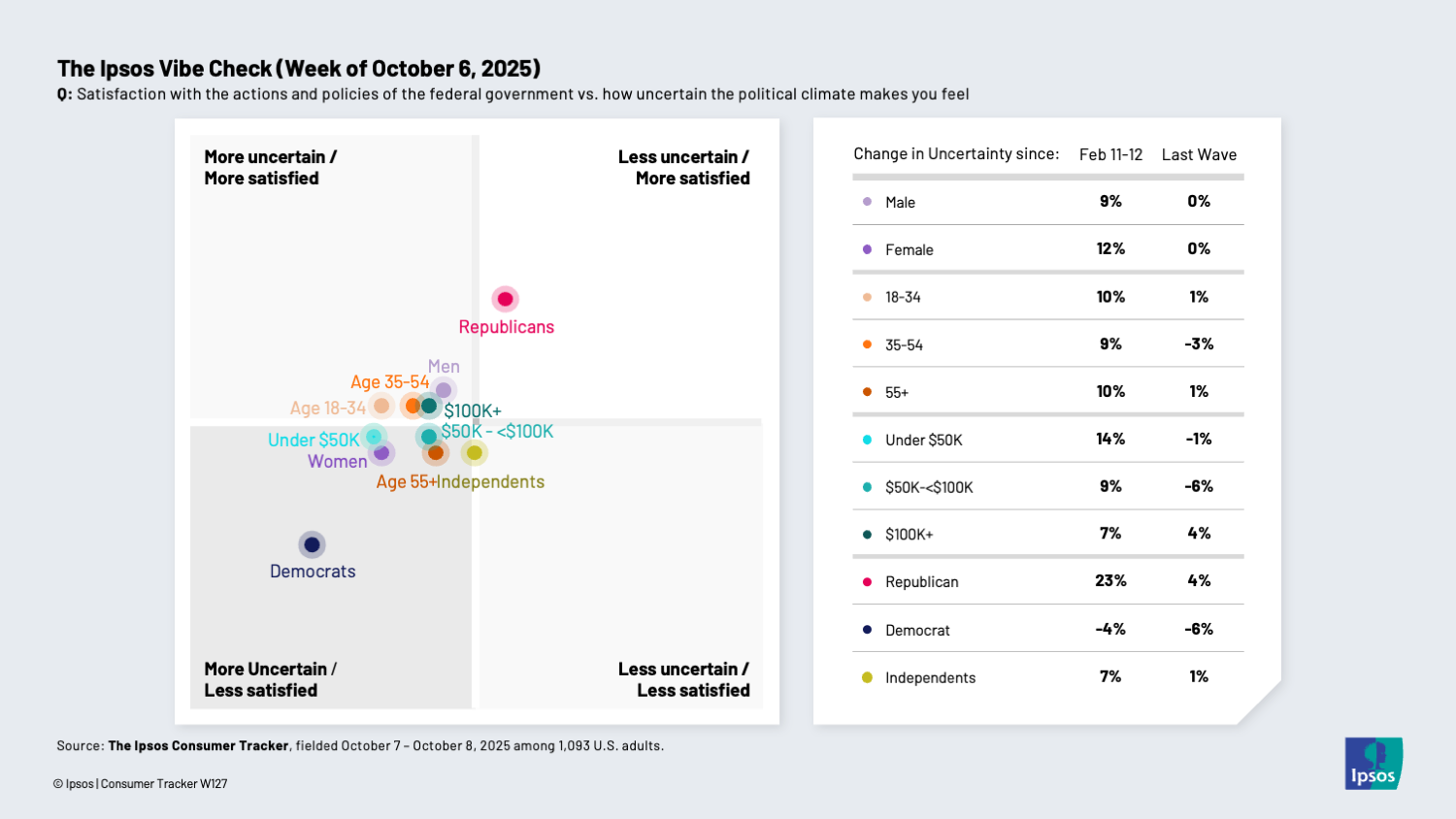
Week of Sept. 23, 2025: This wave sees the even-further striation starting to happen. We’ll see if this keeps up before we read too much into it, but starting really with the last wave, some of the pack started to split apart. Since the Vibe Check began in February, there has generally been one blob floating around the axes (and then Republicans and Democrats in their respective poles). But it’s interesting that we’re starting to tease out two clusters. One is group is moving more toward less uncertain and more toward satisfied. That cluster is demographics that historically tend to lean more Republican (men, older, and more wealthy Americans). It’s always made sense that they would behave more like Republicans, but we hadn’t yet seen them differentiate from the pack. Let’s see if this continues in future waves.
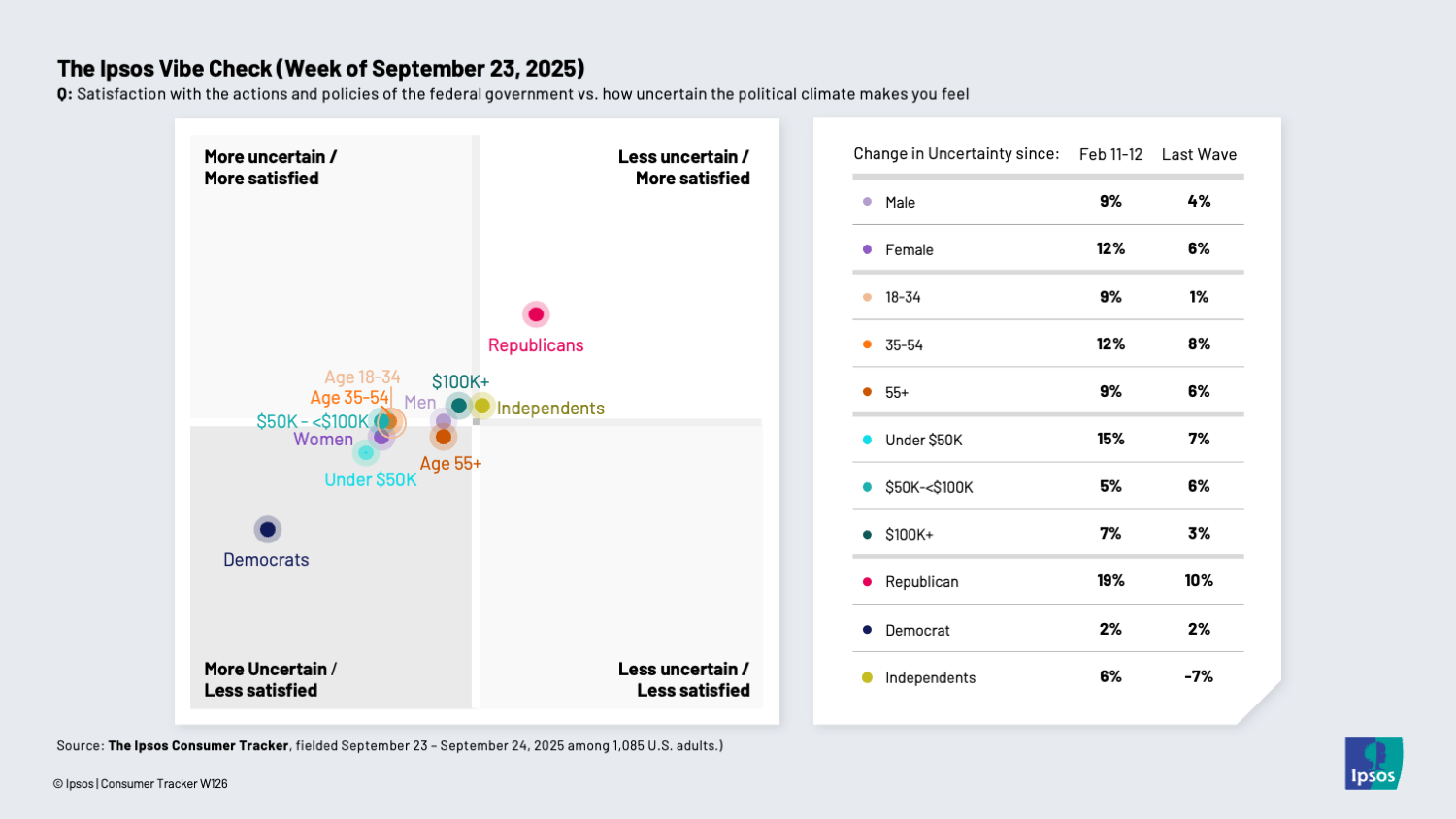
Week of Sept. 8, 2025: This wave saw a couple of groups slide over into the “less uncertain” side of the chart – upper-income and older Americans. Many groups also drifted up into the More Uncertain / More Satisfied quadrant. There had been some mixed news on the economy, per usual, but the news of potential rate cuts coming, mortgage rates lowering and stocks keeping up momentum perhaps has people feeling a little better about things. BUT this was all before the assassination of Charlie Kirk.
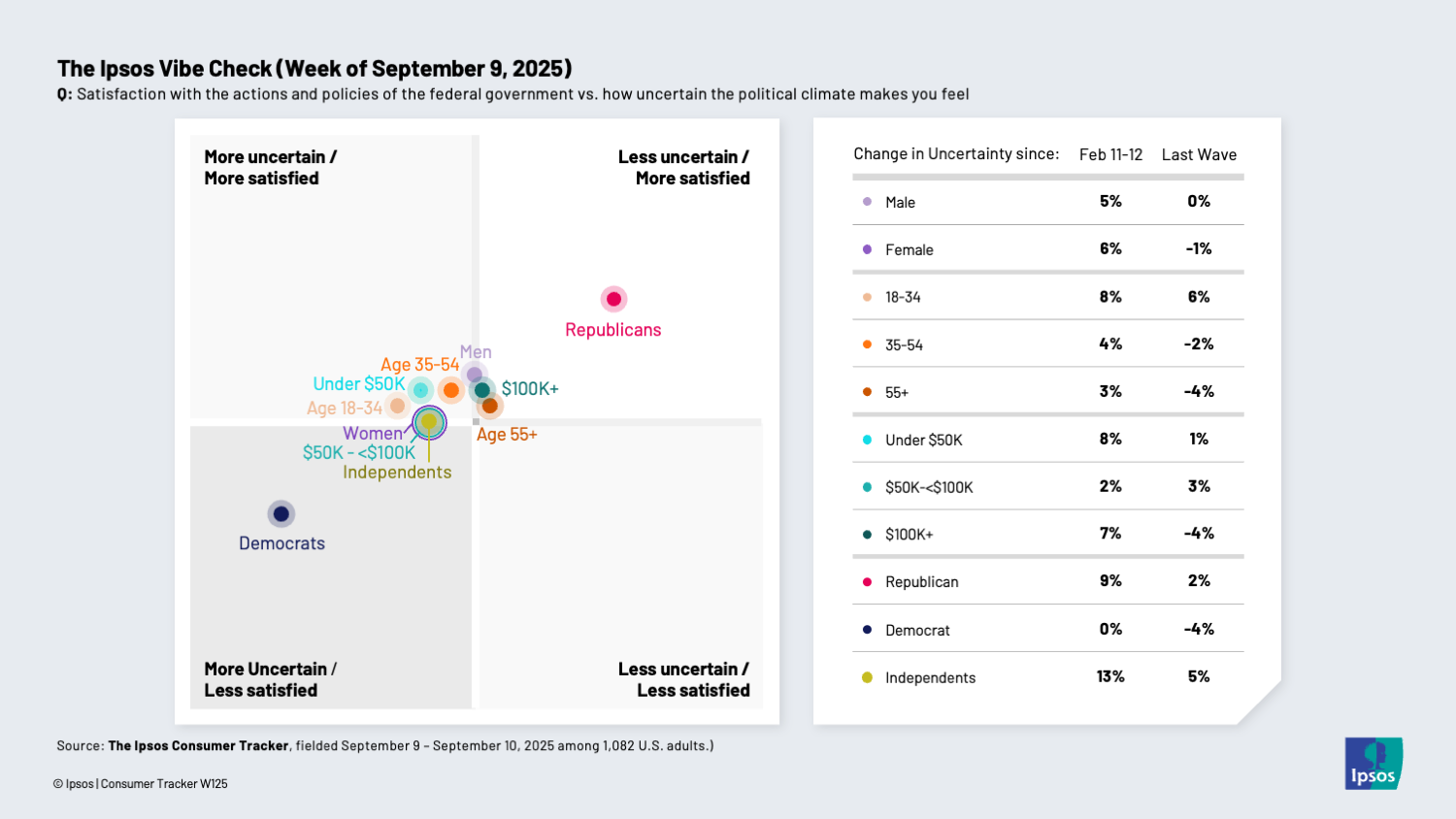
Week of August 26, 2025: This was perhaps the least movement in terms of uncertainty. Everyone except Republicans are on that side of the ledger. But as tariffs really start kicking in, immigration crackdowns continue, public health officials come and go, and federal troops take over the nation’s capital, every demographic (including Republicans) moved more unsatisfied.

Week of Aug. 12, 2025: For the most part, we continue to stay near, but definitely not on, the center. While we are clustered around the axes, most demographics remain solidly and clearly on the “Uncertain” side of things. And they then bounce back and forth over the satisfied lines.
One of the bouncier groups continues to be lower-income households, which makes sense as they are likely to be impacted by public policy to a greater extent than many higher income households. Or at least, are potentially more at risk.
The other vacillating group is independents. First, we should acknowledge a smaller sample size there, which requires caution. But it’s also easy to imagine that some policies really resonate and some really don’t resonate. These are folks who are not sitting firmly in either of the dominant political ideologies. They could easily love deregulation and at the same time not love some implications about privacy or having the military deployed in American cities. So I’m personally finding the fact that they jump from quadrant to quadrant from wave to wave really interesting. Democrats, meanwhile, are just about to fall entirely off the chart as Republicans remain both unshakeable in their support but also not gaining in their support, as we see here and also in presidential approval ratings.
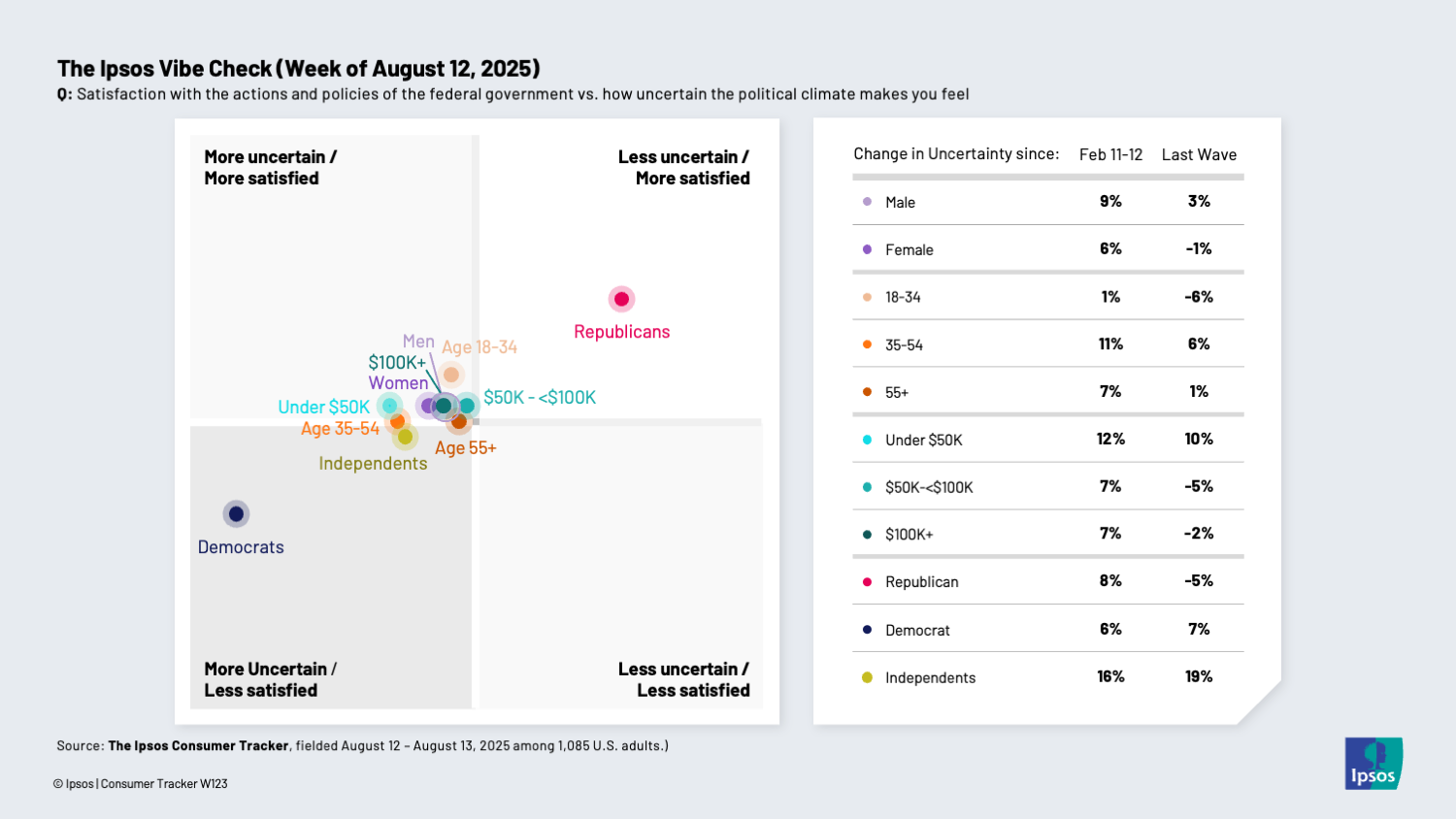
Week of July 28, 2025: Last wave we saw a little bit of striation occurring. What had been a pretty cohesive blob moving around the quadrants had started to pull apart. This wave, we see it coming together a bit more again. Most of the movement is in the margins but it’s worth paying attention to the fact that while folks most groups are clustered on above and below the satisfaction line, everyone except Republicans (and this wave the ever-bouncy independents) are still in the “Uncertain” side of the ledger. That uncertainty can ripple through the economy and the geopolitical sphere in all kinds of ways. Stay tuned, and we’ll keep an eye on the Vibe.
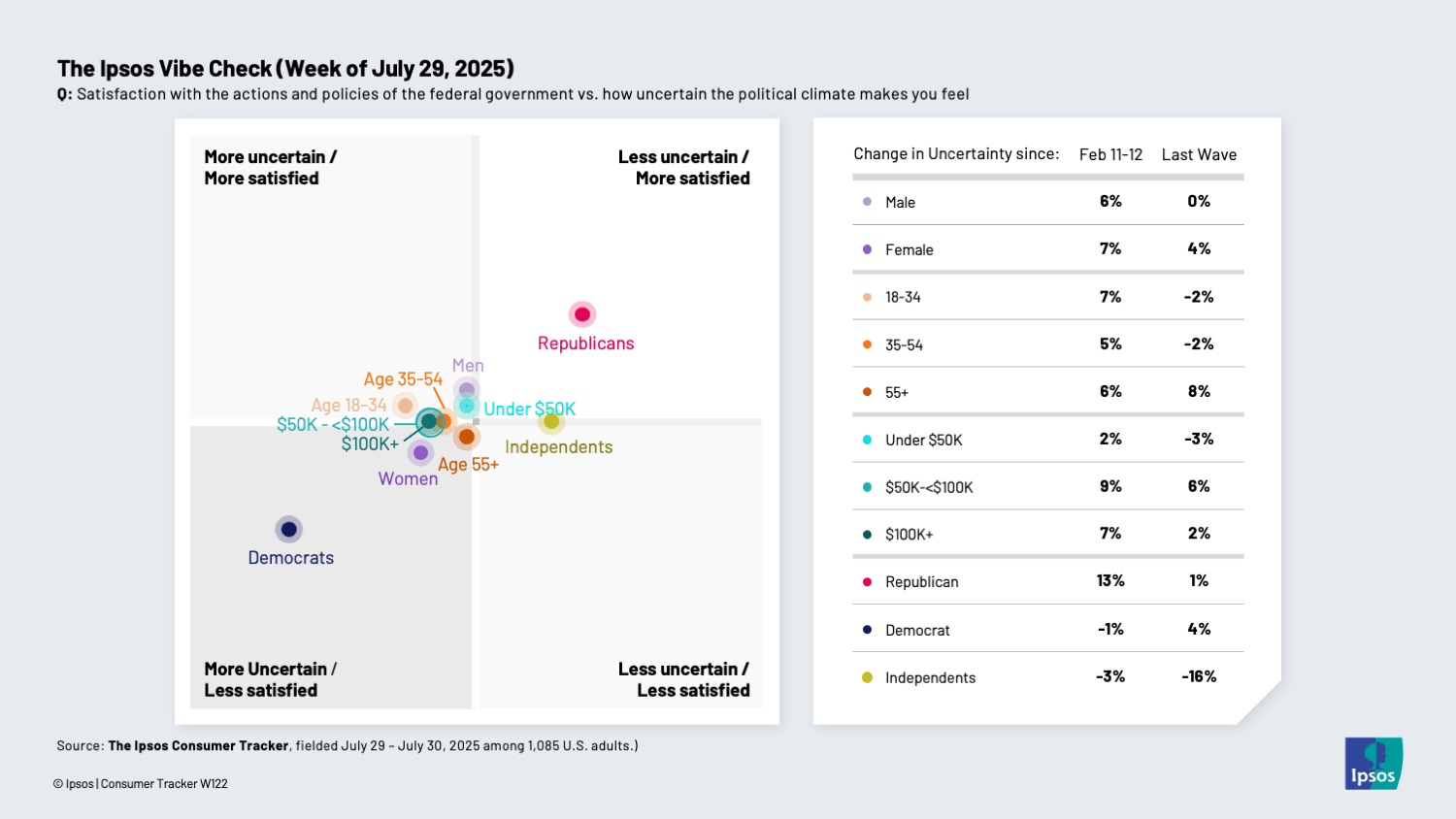
Week of July 15, 2025: We drifted a bit more uncertain this wave
It’s been a month since we last did a Vibe Check and not an inconsequential month at that. Among other developments: the administration’s budget bill passed, plenty more tariff talks, some additional global conflicts, and the baseball All-Star game. Those will have varying impacts on the Vibe.
But the most notable difference in the current wave is that we’re starting to spread out.
Since we launched this in February, most of the demographics have shifted around from wave to wave and generally trended toward the “more uncertain” side of the ledger, whether satisfied or not. But they have generally moved as, to use technical market research terms, a pack or a blob.
This wave sees us spreading out more. The 55+ group has always been a bit of an outlier and now find themselves alone in the weird “less uncertain/less satisfied” quadrant, rather opposite the other two big age breaks. Genders are in different quadrants and getting farther away from each other. Independents continue to be independent. And Republicans and Democrats just live in different worlds.

Week of June 17, 2025: Uncertainty deepens
Most groups drifted a bit more uncertain again this wave. Republicans and the lowest income Americans recorded the biggest swings. Most other groups were in the margins. Geopolitically, things are on rocky footing at the moment. But economically, CNN had a useful article recently about the actual impact of all of the tariffs, roll-backs, postponements and deals made. So far, according to a variety of analyses, the tariff rate is up 12 points this year (a six-fold increase). But that’s nowhere near what was originally expected based on the tariff charts the President announced. That’s not to say changes aren’t still coming. Many of the goods on shelves today shipped to the U.S. before the tariffs took effect.
But from a consumer point of view, things are pretty status quo after seeming really whiplashy earlier in the year. The early dark forecasts were based on the initial super-steep tariffs proposed. Many of those have since been reduced or postponed. And some economists think that prices will still jump as tariff-impacted goods make it on shelves. So we will, of course, keep an eye on all of this.
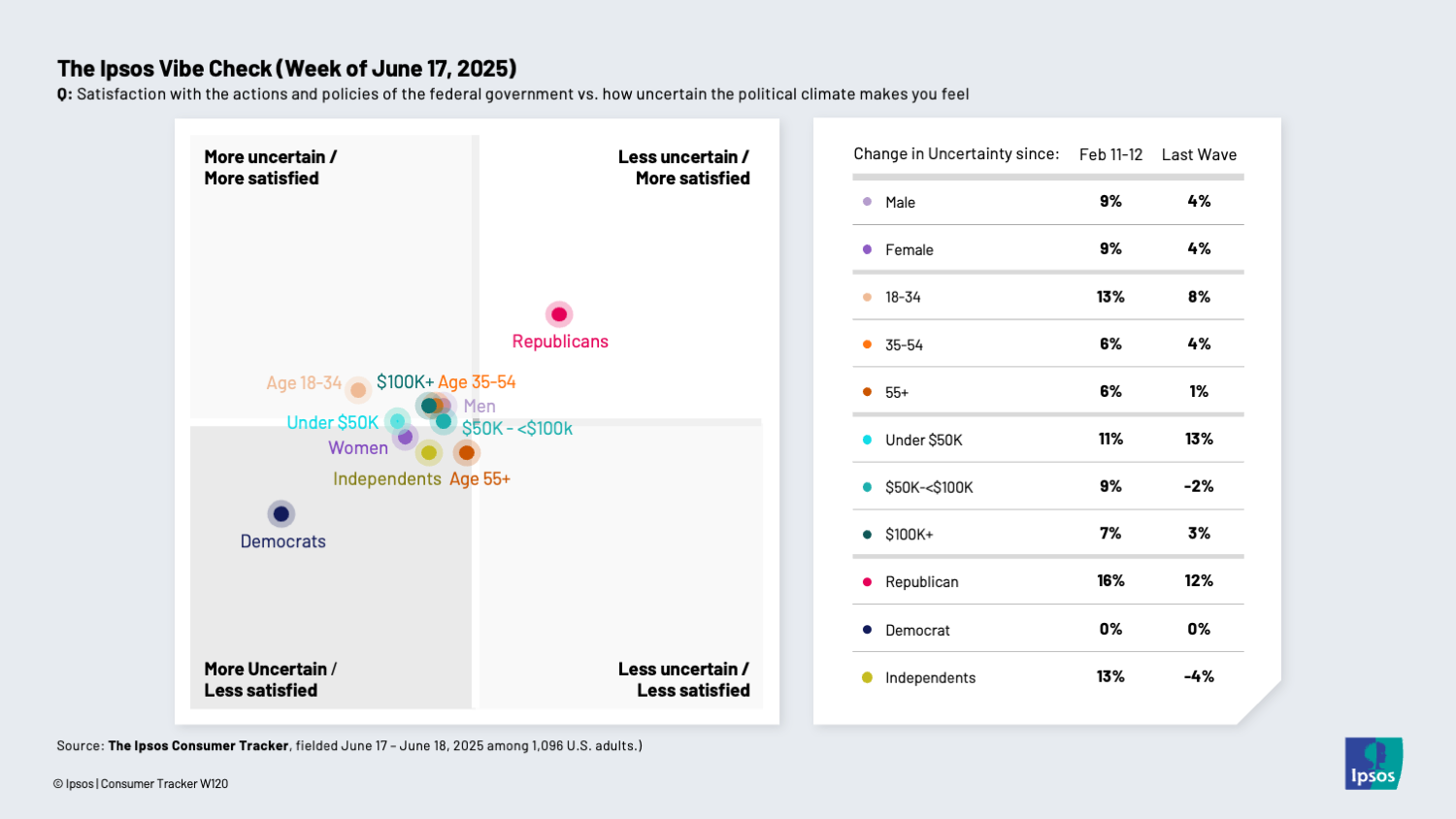
Week of June 3, 2025: We drifted a bit more uncertain this wave
Most groups drifted toward greater uncertainty this wave. The "big, beautiful bill"passed the House, bringing with it sweeping cuts to the size of government and tax cuts. But the Congressional Budget Office points to a multi-trillion-dollar hit to the deficit, and many of the government services being cut are rather popular. Some, notably Elon Musk, don’t think the cuts go far enough. What will make it through the Senate? It’s unclear.
Also unclear is the state of tariffs, but the market has stopped whipsawing based on the tariff news, at least. All of which leaves consumers and business leaders alike still feeling this lingering unease in may ways. But in other ways, we’re still spending (see below). By other ways, I mean good ways and not so good ways. Stay tuned for some new numbers on Buy Now Pay Later in an upcoming Ipsos Data Drop!
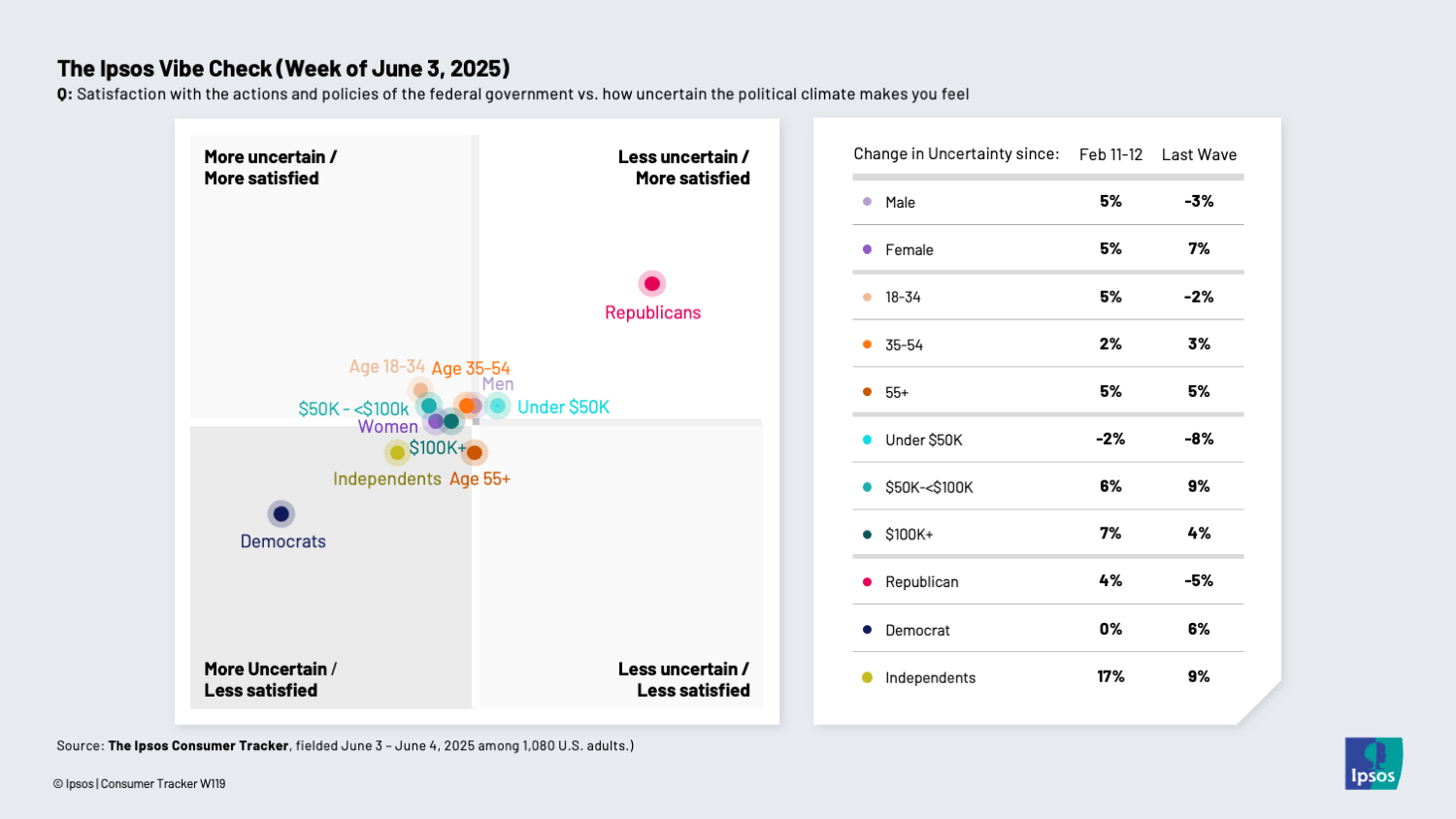
Week of May 19, 2025: Uncertainty is leveling off for now
At the time we fielded, tariff news had seemed to chill out a bit. Most of the tariffs seemed reduced (though still there, and not small in the case of China, just not as large originally promised) or postponed.
But after we came out of field, the House passed the budget bill and President Trump threatened new tariffs on the European Union and smartphones. So of course, we’ll keep an eye on things. The only groups that became more uncertain were younger Americans and, interestingly Republicans. Pretty much everyone’s satisfaction ticked down, but all within the margins.
But perhaps things are leveling off because fewer people think prices are rising, as we saw in another question this wave.
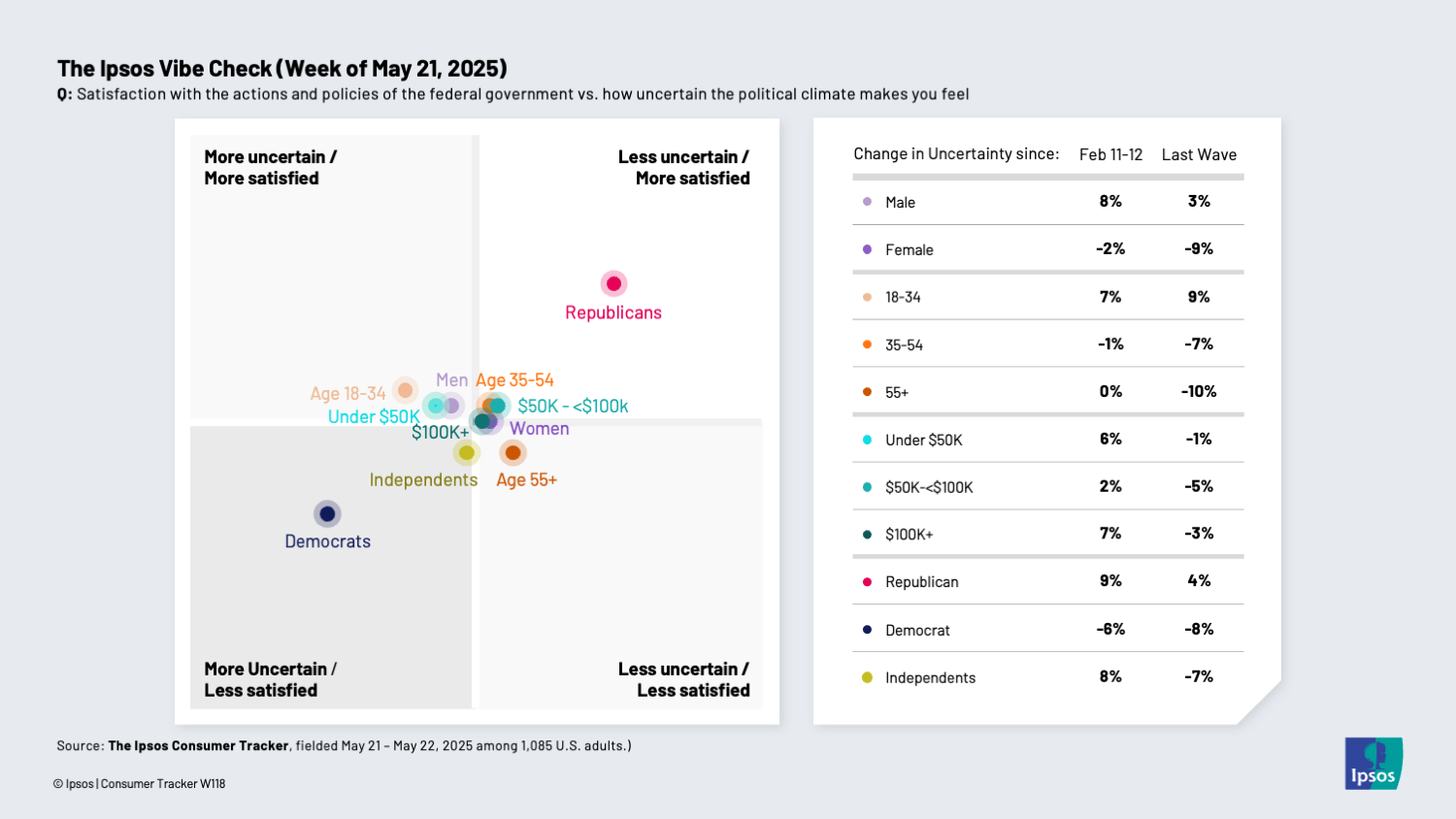
Week of May 5, 2025: Uncertainty persists
So here’s the thing with the Vibe Check, in what is now its third month: This is data that really shouldn’t move too much. It’s a pretty simple set of questions. And yet… here we are, bouncy bouncy bouncy. For the most part, the demographic splits are moving together. Look at the data by income, age, gender, or most other splits and everyone is kinda clustered there in the middle, drifting to more uncertain and less satisfied. The Republicans and Democrats are where you would expect them, though also sliding a little to the lower left.
The independents, however, are just wild. In the first four waves, your swing voters, those not tethered to an ideology, rotated counter-clockwise through all four quadrants. They’re basically the only ones to ever enter the lower right. This wave, they’re starting to pull away from the pack and look more like the Democrats.
When we started this in February, if we looked at the satisfaction question and we saw a lot of ratios of 2:1 or 3:1, in terms of people rating their satisfaction with the government a 1 (very unsatisfied) vs. 5 (very satisfied). Now those have gotten even farther apart. The ones outnumber the fives 5:1, 6:1, and even higher. Young adults 18-34 are deeply, deeply unsatisfied, as are suburban residents. There’s a lot going on here, and it’s starting to seep over into other data, now too. There’s an item in the Care-o-Meter that will likely start moving these dots even more in coming weeks and months.
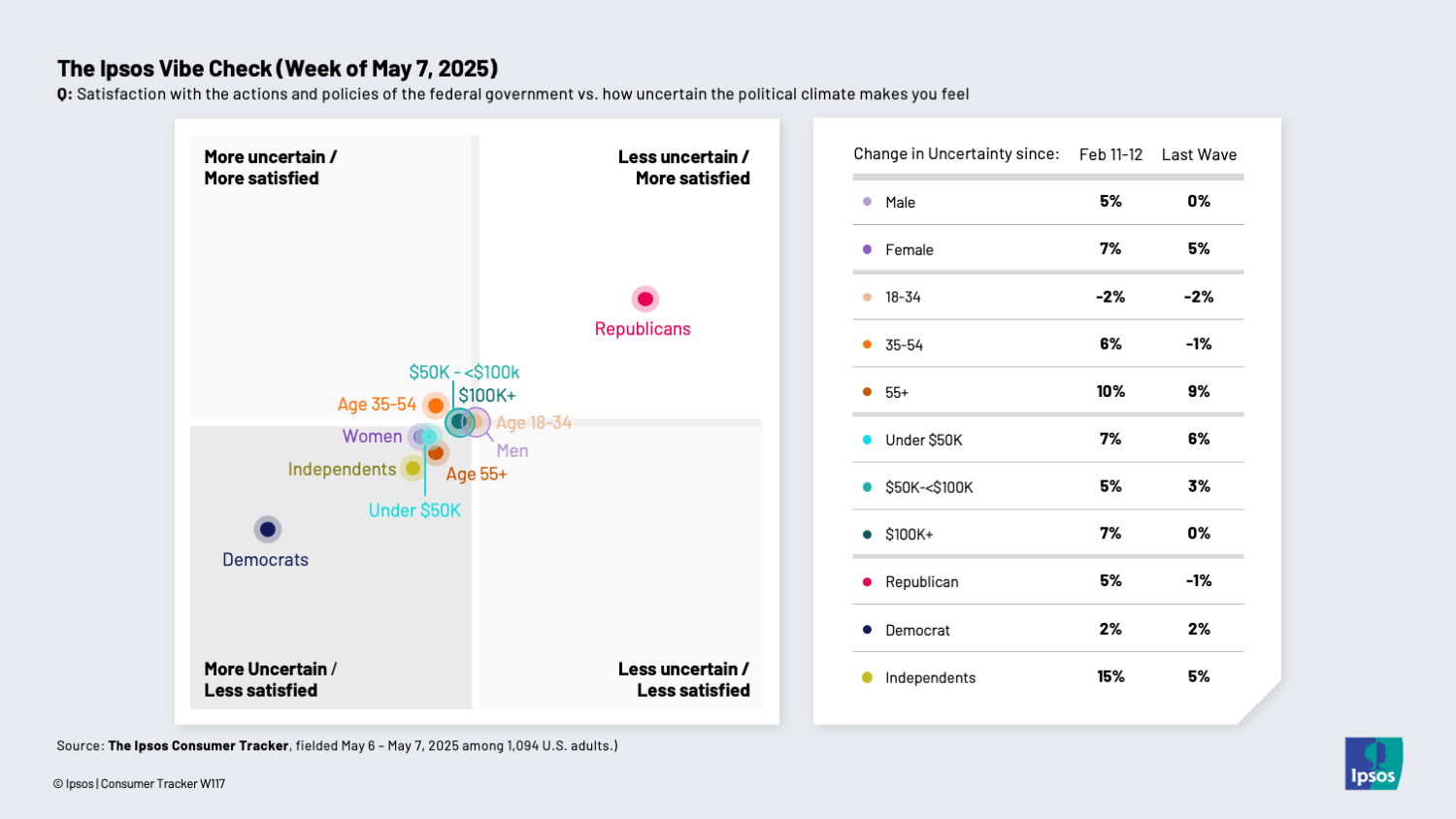
Week of April 21, 2025: Consumers are freaking out a little less
In some ways the bounciness of the Vibe Check is telling: We’re uncertain about how uncertain we are. Which is kind of fascinating when you look at it that way. It’s not hard to imagine why we’re feeling this way. At one point on CNN.com this week the lead story was “We’re suddenly talking about the Great Depression when discussing Trump’s stock market.” But the bullet point below was “Dow surges 1,000 points.”
The Dow has dropped 1,000 points 19 times in its history. Three of those days occurred in April. So, too, did two of the 13 gains of 1,000 points.
Independent voters have been interesting to watch amid all these changes. In the first four waves of the Vibe Check, they moved into each of the four quadrants of the chart. They moved again this wave. Overall, every group had trended decidedly more uncertain before this wave. Now we’re easing off that a little, almost to back where we started in February. Which, in itself, was right around the middle of the chart for most groups, evenly split about how freaked out they were.
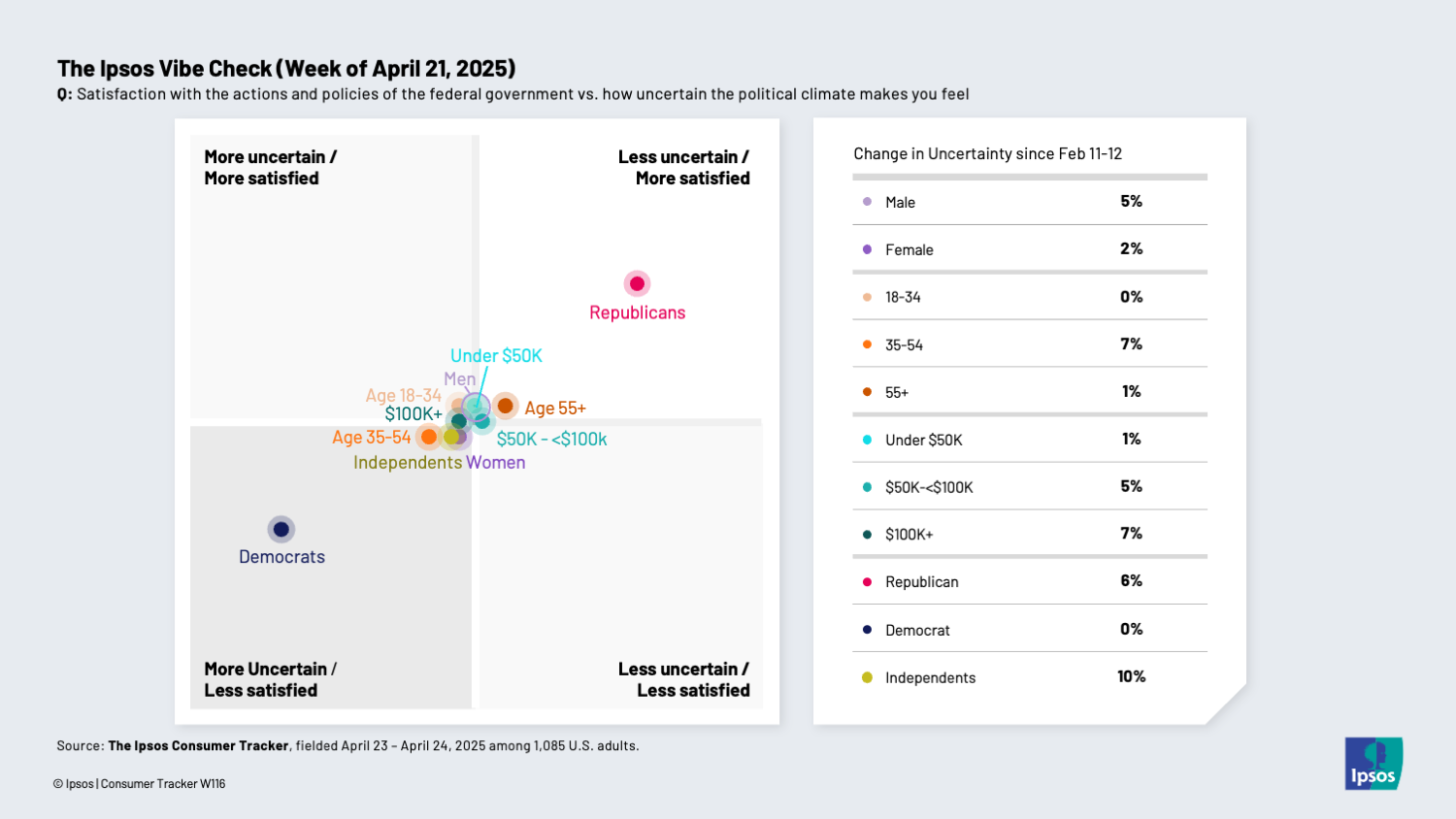
Week of April 7, 2025: Consumers are freaking out about the government
Something is going on with consumers, and they seem to be freaking out. In a chart we’re now calling the Ipsos Vibe Check, we’re measuring uncertainty and satisfaction. We’ve done this now over the last eight weeks and it’s one of those things that shouldn’t really move too far too fast. And yet, there’s a definite shift toward more uncertainty and less satisfaction with the goings on in the government. Now 46% say they have “a lot” of uncertainty (+10pp from February) and an additional 33% have some uncertainty.
If you couple this with the MetLife & U.S. Chamber of Commerce Small Business Index where inflation concerns are at a record level (58%) as are revenue concerns – 35% now cite revenue as a challenge, up 10 points from last quarter – you see a picture of small business owners stressed about both supply and demand. And this was fielded before Trump’s Liberation Day tariffs were announced (and then partially paused).
In the Ipsos Vibe Check, independent voters have been especially bouncy. This wave saw their uncertainty drop back down to the levels we saw originally (after a 23-point spike) but their satisfaction has fallen more than any group. That’s left them into a quadrant all to their own. But perhaps the real story is Republicans, who have seen 13 points of movement toward more uncertainty in just eight weeks. Though interestingly their mean satisfaction has ticked up a bit (to 3.4) and remains almost a full point higher than any other group or the average (2.5).
Meanwhile, checking back in on our threat index question, twice as many Republicans (20%) now say the political climate is a high threat than they did just two months ago when we started tracking this. Other groups are mostly flat at 30% feeling a high threat. Add in almost four in ten who feel at least moderately threatened and that’s… not great. Only 25% say they feel a low or very low threat.
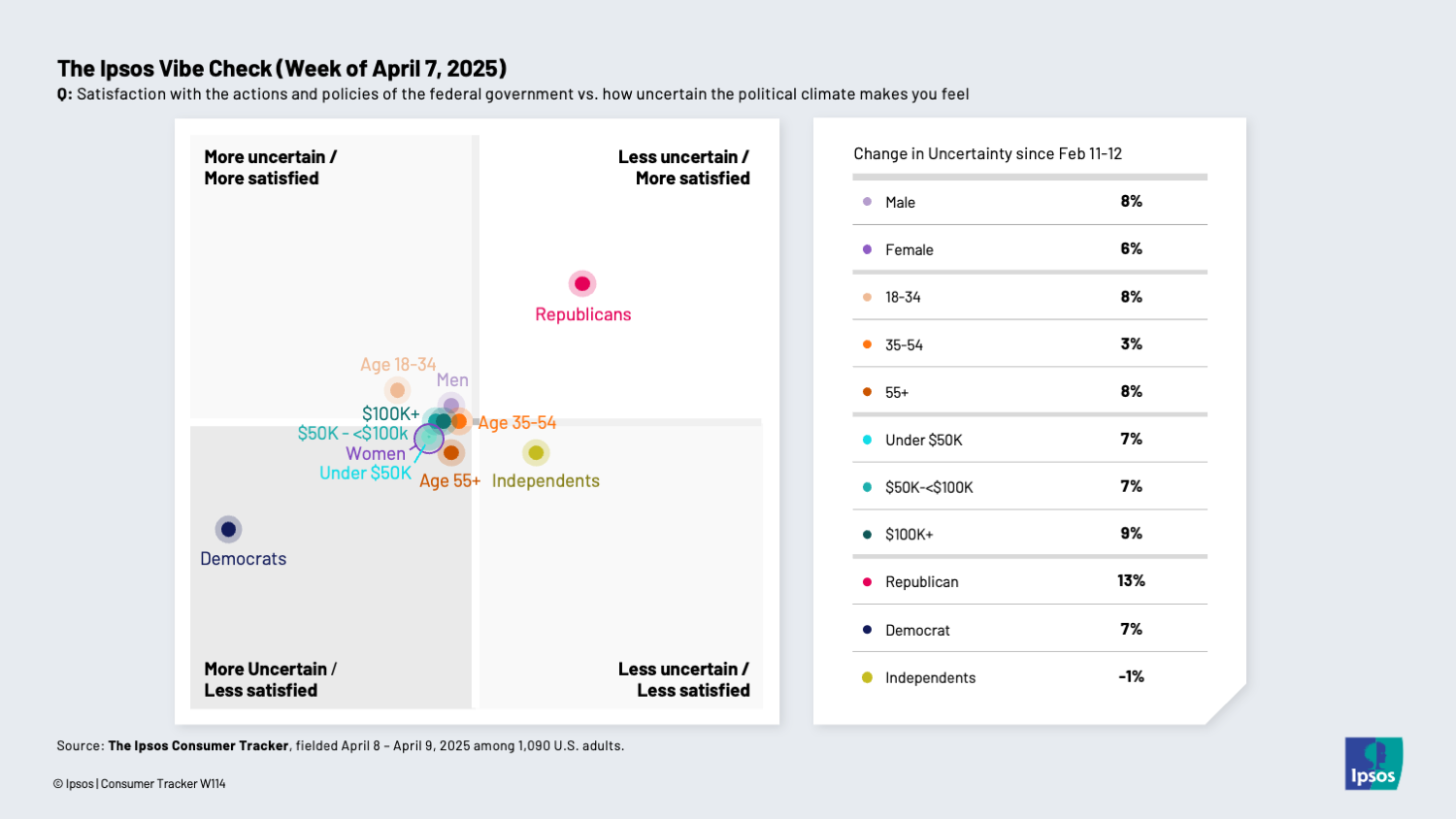
Week of March 25, 2025: Uncertainty grows across America
The new Ipsos Vibe Check shows that uncertainty continues to grow across every demographic, with the biggest shifts among women and the affluent. Oh, and a huge shift (23 points!) among independents. The independents have now fully broken from the pack and are looking a lot more like Democrats in many ways. Things are generally starting to striate a little bit. Also, a majority of every demographic split is now either stuck or has a lot of uncertainty. If you add in the “some uncertainty” it’s close to 90% for everyone except Republicans, and even they show 70% having at least some uncertainty. Satisfaction also fell among most demographics, with again the strongest shift in independents but also the affluent. Now a lot of demographics are under 2.5 on a 5-point scale.
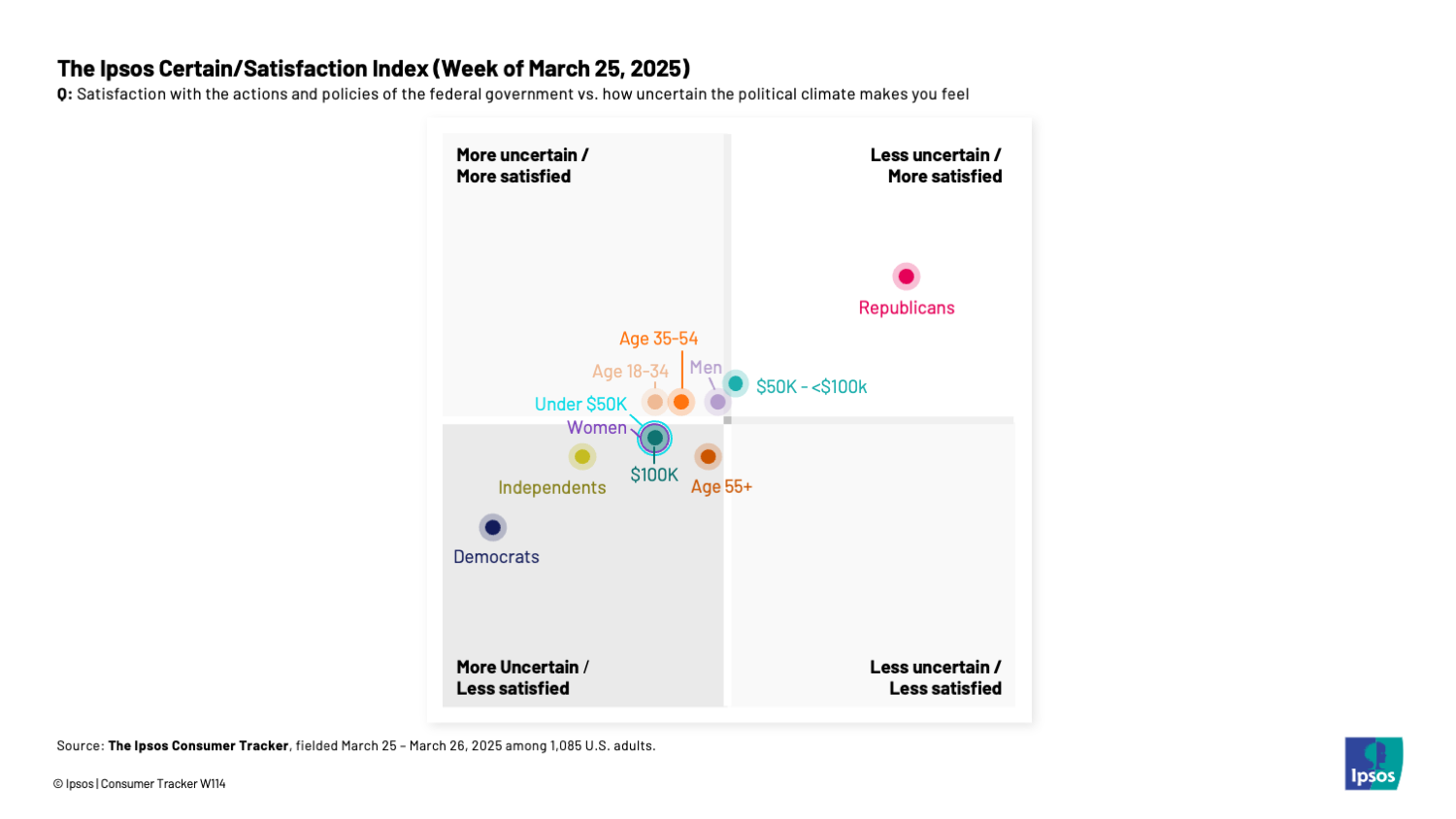
Week of Feb. 24, 2025: Republicans and independents are feeling more threatened
As the Trump administration enacts their agenda at breakneck speed, a lot is changing politically and geopolitically. To some, it feels like five years ago with a high level of uncertainty – maybe even more so. For the first years of the pandemic, Ipsos ran a segmentation called the IPAC. It asked a battery of questions to gauge how America was feeling in the moment. In the last wave, we piloted a modified version about our political climate. We ask three questions. One is about the level of personal threat people feel about the political climate. Then we asked a two-part question, again adapted from the IPAC, looking at how uncertain people feel because of the polices of the federal government, and how satisfied with the federal government.
In the last wave we saw “bad-days-of-COVID”-levels of threat felt by the Democrats. This wave, that has increased overall by 6 points. Now one in three Americans feel a high or very high level of threat. We’re now in even thirds between high threat/moderate threat/low threat. That increase was partly driven by a 5 point increase in the Republican threat level, which is still small (15%), but that’s up 50%. More striking is the jump among independents, who saw their threat level double to 30%. Half of Democrats fall into the high threat group.
On the certainty vs. satisfaction scale, something interesting is going on. Since our last wave just two weeks ago, certainty and uncertainty have flipped. Last wave it was 45% uncertain, now it’s 54% uncertain. Like the threat level, this jump is driven by Republicans and independents. But nearly every demographic split posted some increase in the level of uncertainty.
What’s interesting is that, at the same time, nearly every demographic also posted either flat or somewhat higher levels of satisfaction. Overall, the cluster moved up and to the left from last wave. It will be interesting to watch this over time.
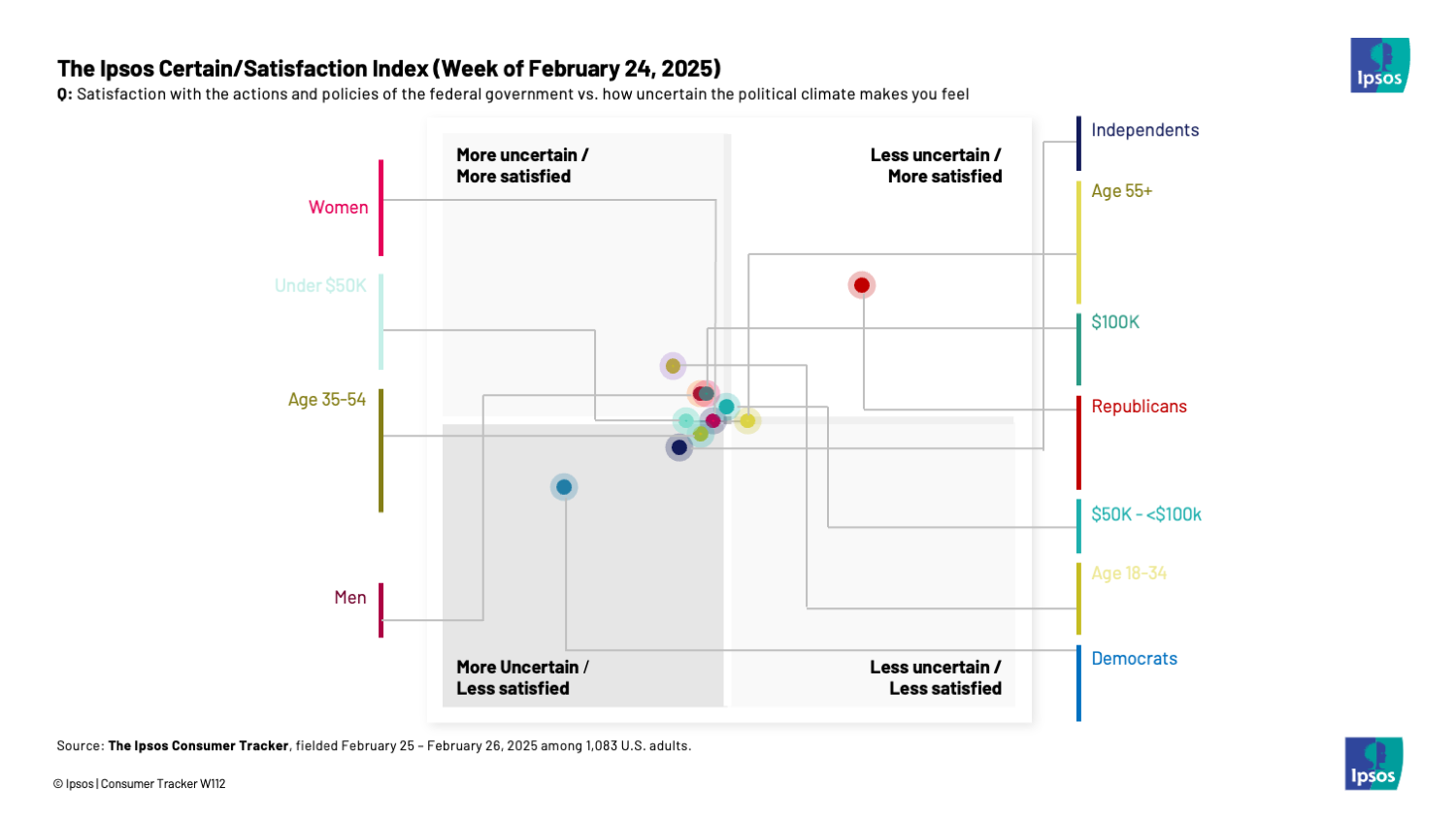
Week of Feb. 11, 2025: The only ID that matters is Party ID
As the Trump administration enacts their agenda at break-neck speed, a lot is changing politically and geo-politically. To some, it feels like five years ago with a high level of uncertainty – maybe even more so. For the first years of the pandemic, Ipsos ran a segmentation called the IPAC. It asked a battery of questions to gauge how America was feeling in the moment.
So, we thought we’d pilot a modified version about our political climate.
One of the IPAC questions was about how much of a personal threat COVID posed. In the height of the pre-vaccine pandemic (July 2020) 28% of Republicans and 41% of Democrats said it posed a high threat. Now, even more Democrats (49%) say the political climate poses a high threat (just 10% of Republicans agree) than thought COVID was a high threat. That’s about where the Democrats were in November 2020, as the Delta variant was spiking to 800,000 cases a day!
We then asked a two-part question, again adapted from the IPAC, looking at how uncertain people feel because of the polices of the federal government, and how satisfied with the federal government.
Today, 12% feel stuck about what to do next. One in three have a lot of uncertainty and another 37% have some uncertainty. Only 15% say they have no uncertainty. If we bucket those into the high (stuck/a lot of uncertainty) and low (some uncertainty/no uncertainty) we are evenly split between those two.
In terms of satisfaction with the government, only 10% say they are very satisfied and about three in 10 say they are very unsatisfied. On this five-point scale, the mean is a 2.6, so just over the halfway point. That’s due to a third of people giving the government a three out of five. “Unsatisfied” outnumbers “Satisfied” by a two-to-one margin (45% to 22%).
That’s all at the surface. But dig in and you see… that basically every demographic split is the same. There’s little to no variation in our uncertainty (evenly split) or our satisfaction (we’re much more dissatisfied than satisfied) across gender, age, race, income, urban/rural, education, employment, marital status, whether we’re working remotely, whether religion is important us, or if we’re hopeful for the future. That’s a ton of really consistent crosstabs.
Then you look at party ID. Hey, look at that.
Democrats are five times as likely to feel stuck (19% to 4%) and three times as likely (56% to 19%) to have a lot of uncertainty. Republicans, not surprisingly, have the highest mean level of satisfaction (3.2) and Democrats have the lowest (1.9). But it’s worth noting that so far, even Republicans are only 41% satisfied, which is four times higher than the Democrats who are 74% DISsatisfied to Republicans’ 21%.
So on the surface, we’re pretty evenly divided, just as we saw in the polls. Beneath the surface we are, too. But when it comes to our party identification, we are moving farther and farther away from each other.
Keep an eye on this, and consider political party identification in all of your research. Party splits crop up in places you might not expect them. They don’t necessarily correlate to any other split. And anything that could potentially become political, quite likely will. See the introductions to What the Future Transportation or Food for some examples.



